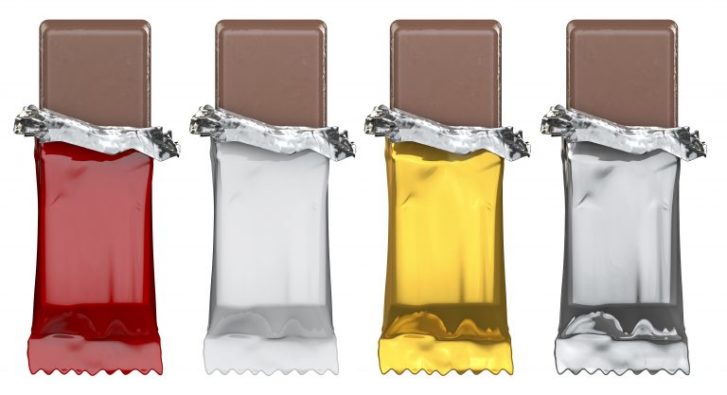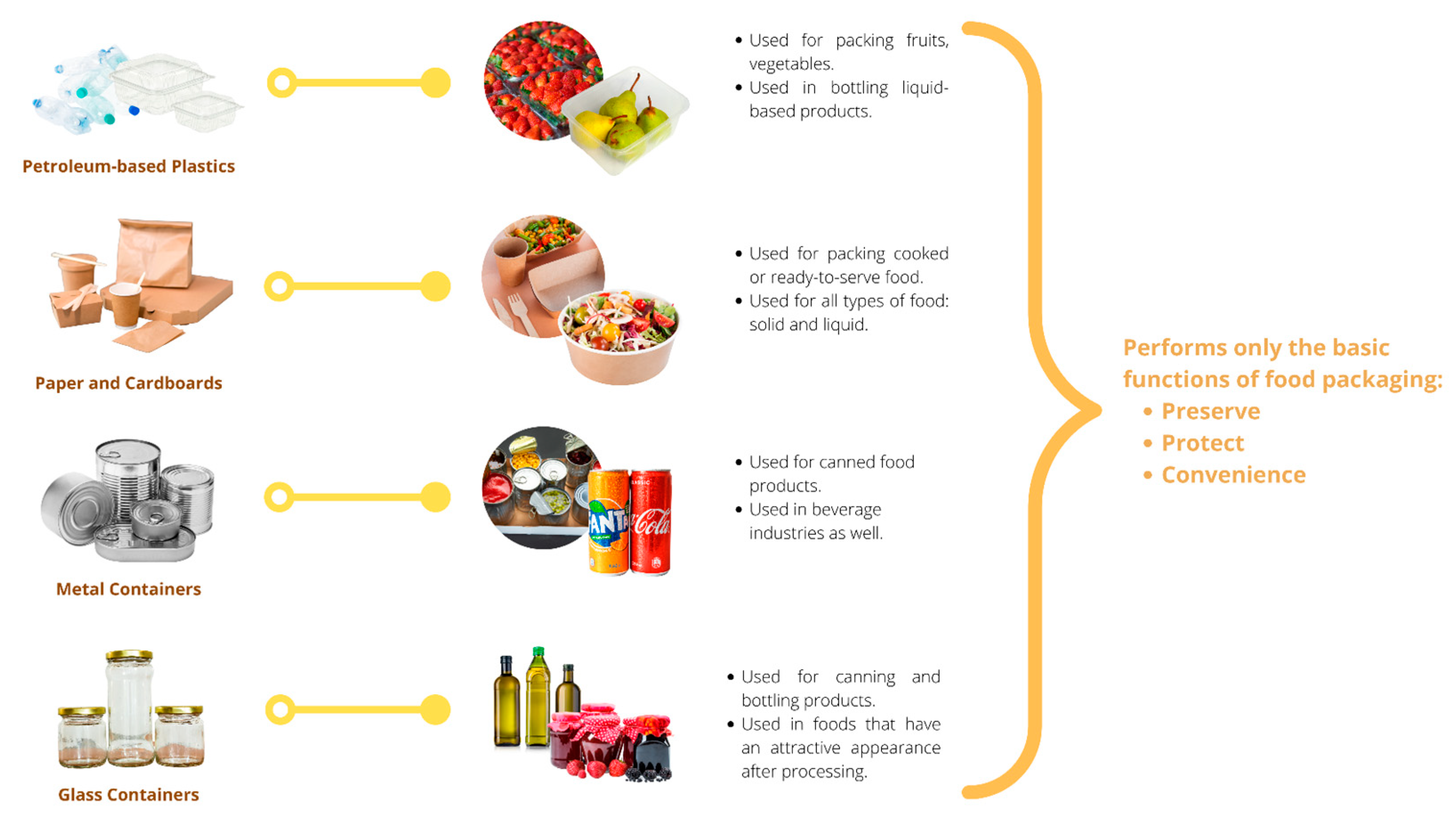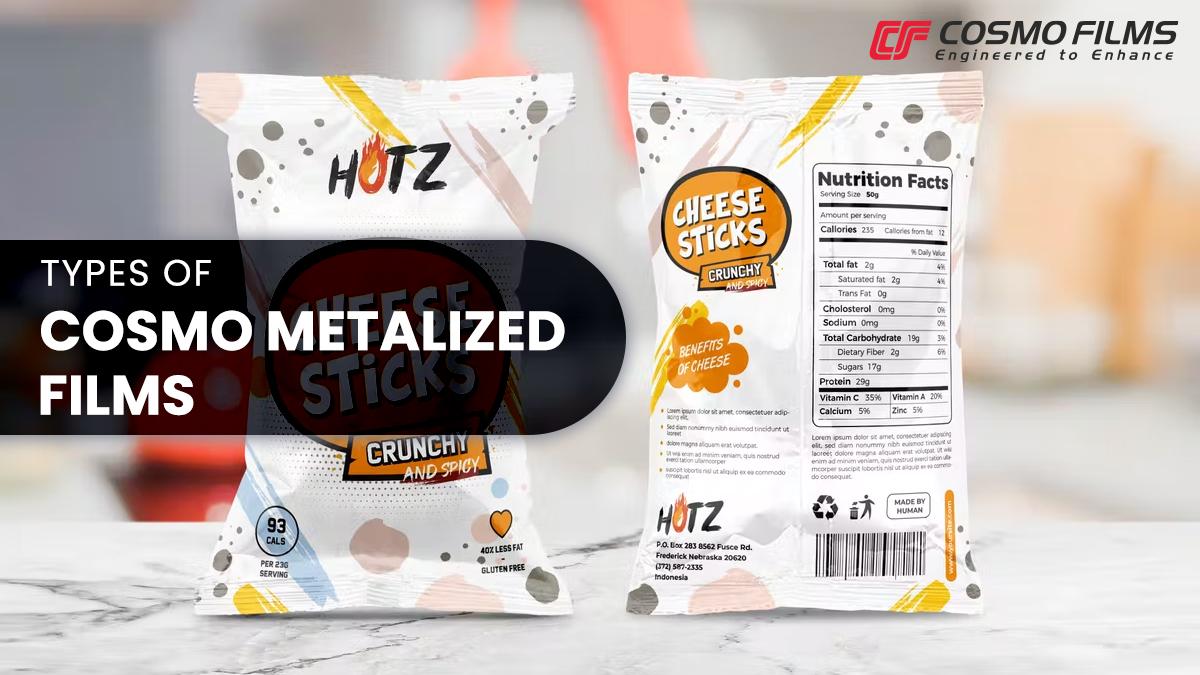What Are Metalized Films and How Are They Used in Packaging Ready-to-Eat Foods?

If you've ever picked up a bag of chips or a ready-to-eat meal, there’s a good chance it came wrapped in metalized film. But what exactly are these films, and why do food makers like them so much? Let’s dive into the world of metalized films in packaging, especially for ready-to-eat foods, and investigate how they work, their types, and why they matter.
What Are Metalized Films and How Are They Made?
Metalized films are thin plastic sheets coated with a very thin layer of metal, usually aluminum. This metal layer is applied through a process called vacuum metallization, where aluminum is heated until it vaporizes inside a vacuum chamber. The metal vapor then settles evenly on the plastic surface, forming a shiny, reflective coating.
The base plastic is often something strong and flexible like Biaxially Oriented Polypropylene (BOPP). BOPP films are stretched in two directions before metallization. This stretching aligns the polymer chains, making the film stronger and clearer.
The result is a film that looks like shiny foil but is much thinner and lighter. This lightweight feature makes metalized films especially attractive for food packaging since they reduce shipping weight and costs.
What Is Metalized BOPP Film and How Does It Enhance Packaging Properties?
Metalized BOPP film combines the benefits of BOPP plastic with the protective power of a metal layer. The aluminum coating dramatically improves the film’s ability to block oxygen, moisture, and light from reaching the food inside. That matters because oxygen and moisture can spoil food or make it stale quickly, while light can degrade flavors and nutrients.
Another key property comes from the surface treatment called corona treatment. This process raises the film’s surface energy, making it easier to print onto. So food brands get bright, bold packaging designs that look great on shelves and catch consumer eyes.
Metalized BOPP films also maintain sealing strength. This means the package stays closed and fresh during shipping and storage. The flexibility of BOPP allows packaging to take on various shapes — from bags and pouches to wraps and labels.
What Types of Metalized Films Are Available for Ready-to-Eat Food Packaging?
There are several kinds of metalized films tailored for different packaging needs. Here’s a quick list explaining their main uses:
| Type | Features & Uses |
|---|---|
| Non-heat sealable | Used mainly for overwrap or secondary packaging where heat sealing is not needed. |
| High-bond crack resistant | Tough films that resist cracking during shipping or bending. Great for bulky or heavy foods. |
| Normal barrier | Cost-effective choice for snacks and less sensitive food. Offers good moisture and oxygen resistance. |
| High barrier | Offers superior protection against oxygen and moisture. Ideal for sensitive ready-to-eat meals, dairy, and meats. |
| Matte metalized | Non-reflective surface for a premium, high-end look while maintaining barrier properties. |
Each type balances cost, protection level, and appearance based on the food product’s needs.
How Do Metalized Films Improve Moisture, Oxygen, and Light Barrier Properties?
Metalized films create a near-impermeable shield on plastic. The thin aluminum layer reflects light, blocks oxygen molecules, and prevents water vapor from passing through easily. Compared to regular plastic films, metalized films sharply reduce moisture and oxygen penetration.
- Oxygen barrier: Stops oxygen from entering the package, slowing bacterial growth and oxidation. This helps prevent stale flavors and spoilage.
- Moisture barrier: Keeps water vapor out, preventing sogginess and growth of mold or yeasts.
- Light barrier: Reflects harmful UV and visible light, protecting delicate nutrients, colors, and aromas.
Thanks to these barriers, food products maintain freshness longer. This preservation extends shelf life from just days to sometimes months, depending on the food.
What Impact Do These Barrier Properties Have on the Preservation of Ready-to-Eat Foods?
Barrier properties are critical for ready-to-eat foods. These products are often eaten as convenience meals and need to stay fresh after packaging. Metalized films help in several ways:
- Shelf life extension: Blocking oxygen and moisture keeps food fresher longer. This reduces food waste and saves money for producers and consumers.
- Nutrient preservation: Protecting food from light helps vitamins and antioxidants remain intact.
- Aroma and flavor retention: The sealed barrier keeps in aromas, so food tastes as intended.
- Protection from contamination: Metalized films form a strong shield against dust, dirt, and bacteria.
For example, snack foods like chips use metalized films for crispness, while ready meals depend on high barrier films to keep ingredients safe and delicious.
How Do Metalized Films Support Packaging Design, Printability, and Branding Efforts?
The metal layer provides a smooth, printable surface that brings brand visuals to life. Because the films are corona treated, inks stick well and print in vibrant colors, making packaging eye-catching on store shelves.
Manufacturers can choose from:
- Glossy metalized films: Bright and shiny, catching the consumer’s eye.
- Matte metalized films: Provide a soft, elegant look appealing to premium products.
- White opaque metalized films: Offer a clean background for colorful designs without loss of barrier quality.
This versatility helps brands stand out and convey quality, freshness, or luxury.
What Are Typical Ready-to-Eat Food Products That Use Metalized Film Packaging?
Metalized films are common in many ready-to-eat items. Here’s a short list of popular uses:
- Snack foods: Chips, popcorn, pretzels, nuts.
- Bakery products: Cookies, cakes, and pastries.
- Cold cuts and deli meats: Sliced ham, turkey, or salami.
- Dairy items: Yogurts, cheese portions.
- Seafood: Smoked fish, packaged shrimp.
- Ready meals: Pre-cooked or frozen meals sealed in pouches.
- Confectionery: Candy and chocolates.
Their excellent protection and visual appeal make metalized films a smart choice for these foods.
Using metalized films in packaging ready-to-eat foods brings many benefits. With strong barriers against oxygen, moisture, and light, plus high print quality options, metalized BOPP films help food stay fresh longer and look better on shelves. Brands get durability, flexibility, and a premium feel without adding bulk or weight. As you can see, metalized films play a key role in delivering fresh, safe, and attractive ready-to-eat foods to consumers.
How Do Metalized Films Improve Shelf-Life, Safety, and Sustainability in Ready-to-Eat Food Packaging?

When I investigate applications of metalized films in packaging ready-to-eat foods, I find that these films are game-changers. They extend shelf life, protect food safety, and contribute to a more sustainable future.
How Do Oxygen and Moisture Barriers Prevent Spoilage and Bacterial Growth?
Metalized BOPP films feature a thin aluminum layer that blocks oxygen and moisture. Oxygen promotes bacterial growth and causes fats to oxidize, which spoils food. Moisture can cause sogginess and mold. By stopping oxygen and moisture from reaching the food, these films prevent spoilage and maintain freshness longer.
- Oxygen barrier slows down bacterial activity and oxidation.
- Moisture barrier keeps foods crisp and dry.
- This barrier combo extends shelf life by days or even months, depending on the food.
For example, snack foods like chips stay crunchy longer, and ready meals retain flavor. These barriers reduce food waste by preventing early spoilage during transport and storage.
How Does UV and Light Protection Preserve Flavor and Nutrients?
UV rays and light can degrade vitamins, flavor, and color in food. The reflective aluminum surface of metalized films blocks UV light effectively.
- UV protection helps preserve nutrients such as vitamin C.
- It prevents flavor loss and color fading.
- This protection keeps ready-to-eat meals tasting fresh and looking appetizing on shelves.
Because of this, manufacturers trust metalized films for packaging dairy, meats, and seafood, where quality must stay intact.
How Does Metalized Film Packaging Reduce Food Waste and Improve Inventory Control?
Extended shelf life means less food thrown away due to spoilage. Retailers see fewer expired products, lowering losses. Consumers enjoy fresher goods, reducing home waste.
Moreover, better preservation helps inventory control:
- Longer-lasting products allow for more flexible stock rotation.
- Reduced spoilage leads to fewer emergency discounts.
- This improves profitability across the supply chain.
A study found that metalized barrier films cut food waste in snack packaging by more than 15%, a significant improvement for retailers and consumers alike.
What Are the Contamination Protection Benefits Provided by Metalized Films?
Metalized films create a strong shield against contamination by dust, dirt, bacteria, and odors.
- Their impermeable layer prevents external contaminants from reaching food.
- They also resist moisture, oils, and tearing, which protects integrity.
- Because the films are heat-sealable, they maintain airtight seals, stopping bacteria from entering.
This reduces the risk of foodborne illness and improves consumer safety.
How Do Metalized Films Compare with Traditional Packaging Materials?
| Feature | Metalized BOPP Films | Paper / Traditional Plastics |
|---|---|---|
| Oxygen/ Moisture Barrier | Excellent | Poor to moderate |
| Heat Sealability | High | Usually low |
| Flexibility | High | Limited |
| Weight | Lightweight | Heavier |
| Cost (initial) | Higher | Lower |
| Cost (total) | Lower (due to less waste) | Higher (due to spoilage) |
| Printability | Superior | Moderate |
| Shelf Appeal | Premium metallic finish | Plain or matte |
Metalized films reduce shipping costs due to lower weight and packaging volume. Their premium look also helps products stand out on shelves.
What Environmental Considerations Exist Regarding Metalized Films?
Environmental impact is a key question in metalized film use. Many metalized BOPP films are recyclable and require less energy to produce versus alternative materials like multi-layer laminates.
- They reduce packaging material by combining barrier and strength properties in one film.
- Less food wasted means a lower overall carbon footprint.
- The carbon impact of metalized BOPP films is smaller than expected when factoring in waste reduction and energy efficiency.
How Recyclable and Sustainable Are Metalized BOPP Films?
Metalized BOPP films are recyclable along with other polypropylene materials. Recycling rates depend on local waste management systems, but they are more eco-friendly than mixed-material solutions.
- They use thinner aluminum layers than aluminum foil.
- This lower metal content helps recyclers process films with standard plastic waste.
- Advancements in chemical recycling are making recovery even easier.
The lightweight nature of these films also lowers transportation emissions.
How Have Innovations Like Oxo-Biodegradable Metalized Films Improved Environmental Compatibility?
Recent advances introduce oxo-biodegradable metalized films. They combine:
- Traditional metalized barrier benefits.
- Additives that promote breakdown under UV light and oxygen exposure.
These films degrade faster in the environment without forming harmful microplastics. This offers a greener option for ready-to-eat packaging.
Key Takeaways
- Metalized films prevent spoilage by blocking oxygen and moisture.
- They shield foods from UV and visible light to protect flavor and nutrients.
- Extended shelf life helps reduce food waste and cut costs.
- Contamination protection keeps foods safer and fresher.
- Compared to paper or plastics, they offer better barriers and premium looks.
- Many metalized BOPP films are recyclable, lowering environmental impact.
- Oxo-biodegradable films bring promising eco-friendly solutions.
Metalized films are a powerful tool for food safety, freshness, branding, and sustainability in ready-to-eat food packaging. Their unique benefits help producers meet consumer demands while easing environmental concerns.
What Are the Challenges and Innovations in Using Metalized Films for Ready-to-Eat Food Packaging Inspection and Market Growth?

Metalized films have become popular in ready-to-eat food packaging. They offer great protection against moisture, oxygen, and light. But while they help keep food fresh and appealing, these films pose some big challenges, especially in food safety inspection and detection of contaminants. Let’s dive deeper into these challenges and how new technologies and market trends address them.
Why do metalized films complicate standard metal detector inspections in food safety?
Metal detectors work by sensing magnetic fields disturbed by metal contaminants in food. But metalized films contain a thin aluminum layer. This layer creates a constant metal signal that masks any metal foreign objects inside the package.
- Metalized films cause false positives or make it impossible for metal detectors to spot smaller metal fragments.
- The aluminum reflection acts like a shield, confusing the metal detector’s ability to isolate foreign metals from packaging metals.
- This issue affects safety in foods packaged with Biaxially Oriented Polypropylene (BOPP) films coated with aluminum for barrier and visual effects.
Here’s why this matters: Many ready-to-eat snacks and meals use metalized BOPP films due to their excellent moisture and oxygen barrier properties. Yet, producers must still ensure no metal bits, glass, or stones contaminate the product. Metal detectors alone can’t do this on metalized packaging.
How do X-ray inspection systems overcome challenges in detecting contaminants through metalized films?
X-ray machines use a different principle. They do not rely on magnetic detection but on density differences inside packages. This change lets them detect contaminants even with metalized films.
- X-rays spot density changes caused by foreign objects like metals, glass, bone, and stones.
- The aluminum layer of metalized films doesn’t block these density contrasts significantly.
- X-ray systems can also reveal product defects such as broken snack bars or missing fillings.
- As metalized films are thinner than metal cans, the detection of contaminants through them improves.
For example, a study showed that X-ray inspection successfully detected metal and other contaminants inside ready-to-eat snacks wrapped in metalized films. This reduces food recalls and safeguards brand trust.
What advanced inspection technologies or adaptations are used for metalized packaging in ready-to-eat foods?
Besides X-ray, advanced techniques improve inspection's accuracy:
- Multi-energy X-ray scanners offer better material discrimination between packaging and contaminants.
- Image processing algorithms help reduce false alarms from metal layers by isolating the aluminum reflection.
- Complementary sensors like near-infrared or vision inspection add extra contaminant detection layers.
- Some manufacturers customize calibration for metalized films to improve sensitivity without losing throughput.
Additionally, inline X-ray systems integrated with high-speed packaging lines support continuous inspection without slowing production.
How can manufacturers balance barrier benefits with effective contaminant detection?
Checking contaminants while keeping barrier performance can be tricky:
- Opt for metalized films with optimized aluminum thickness to retain barriers but reduce metal interference.
- Use laminate films combining metalized layers with transparent plastics to enhance detectability.
- Invest in X-ray inspection systems designed to work with metalized films. For instance, systems compatible with horizontal form fill seal (HFFS) and vertical form fill seal (VFFS) machines.
- Regular validation and testing of inspection lines after packaging changes ensure food safety remains the priority.
Manufacturers often weigh the cost premium of metalized films against benefits like extended shelf life, enhanced branding, and reduced food waste.
What recent industry innovations or case studies demonstrate effective use of metalized films in packaging?
Here are some notable examples:
| Innovation / Case Study | Description |
|---|---|
| Metalized BOPP films with high barrier | Packaging sensitive ready meals with longer shelf lives and X-ray compatible. |
| Metalized Cavitated White Opaque Film | Moisture barrier and bright white backgrounds improving printability and contaminant visibility. |
| Metalized oxo-biodegradable films | Reduce environmental impact without sacrificing barrier properties. |
| Snack producer case study | 40% reduction in foreign object recalls and 10% less food waste after switching to metalized films and advanced X-ray inspection. |
| Dairy and meat reclamations | Metal contaminants represent only 6.2% highlighting detection of multiple foreign objects. |
How is the metalized packaging market growing, particularly in regions like India?
India leads rapid growth in metalized packaging due to rising demand for safer, longer-lasting processed foods. Key points:
| Market Aspect | Data / Trend |
|---|---|
| CAGR (2024-2029) | 26.7% annually |
| Demand Drivers | Increasing urbanization, snack consumption |
| Popular Applications | Snacks, ready meals, bakery items |
| Packaging Machine Compatibility | HFFS, VFFS available |
| Sustainability Focus | Rising interest in recyclable and biodegradable options |
With India's dynamic food sector and export potential, metalized films combine premium shelf appeal and food safety assurance, making them a top packaging choice.
What are practical considerations for food producers switching to metalized film packaging regarding inspection and equipment?
Food producers thinking about metalized films should consider:
- Inspection system compatibility: Ensure existing metal detectors may need replacement with X-ray or hybrid systems.
- Calibration and validation: Invest time and resources in adapting and validating inspection equipment.
- Training: Operators must understand new equipment and the nuances of inspecting metalized packaging.
- Cost implications: Expect initial investment in equipment and material costs, but offset by reduced product waste and recalls.
- Packaging design: Select metalized film variants based on product sensitivity and inspection needs.
- Sustainability: Evaluate recyclable and biodegradable metalized films to meet eco-friendly goals.
In practice, switching to metalized films without changing inspection systems can risk food safety. Upgrading to X-ray and advanced imaging is often necessary for effective contaminant detection.
Using metalized films in ready-to-eat food packaging offers many benefits but comes with inspection challenges. X-ray and innovative technology solutions now allow manufacturers to enjoy barrier benefits while ensuring food safety and market success.
Additional Table on Packaging Inspection Technologies
| Technology | Principle | Benefits with Metalized Films | Limitations |
|---|---|---|---|
| Metal Detection | Electromagnetic signal | Widely used, low cost | False positives with metalized film interference |
| X-ray Inspection | Density contrast | Detects metal, glass, stones through metalized films | Higher cost but more reliable |
| Multi-energy X-ray | Material discrimination | Improved contaminant identification | Complex setup, costlier |
| Vision/Near-Infrared | Optical imaging | Detects visual defects and some contaminants | Limited for non-visible contaminants |
This table helps understand how inspection technologies align with the challenges posed by metalized films.
This concludes the blog content with images inserted below each H2 heading and tables added to visualize relevant data from the content.
FAQs about Investigate applications of metalized films in packaging ready-to-eat foods
What Are Metalized Films and How Are They Made?
Metalized films are thin plastic sheets coated with a thin aluminum layer through vacuum metallization, resulting in a shiny, lightweight film that reduces shipping weight and costs.
How Does Metalized BOPP Film Enhance Packaging Properties?
Metalized BOPP film improves oxygen, moisture, and light barrier properties, maintains sealing strength, allows flexible packaging shapes, and offers a printable surface for vibrant packaging designs.
What Types of Metalized Films Are Available for Ready-to-Eat Food Packaging?
Types include non-heat sealable, high-bond crack resistant, normal barrier, high barrier, and matte metalized films, each balancing cost, protection level, and appearance for specific food packaging needs.
How Do Metalized Films Improve Shelf Life and Food Safety?
Metalized films create barriers against oxygen, moisture, and light that prevent spoilage, bacterial growth, nutrient degradation, and contamination, thereby extending shelf life and maintaining food freshness.
What Challenges Do Metalized Films Pose for Food Safety Inspection and How Are They Overcome?
Metalized films interfere with metal detector inspections due to their aluminum layer causing false positives, but X-ray inspection systems and advanced imaging technologies effectively detect contaminants through these films.
Metalized films boost ready-to-eat food packaging by improving shelf life, safety, and branding. They block moisture, oxygen, and light, keeping food fresh longer. Different types fit various needs, from heat seals to matte finishes. These films cut food waste and support sustainability goals through recyclability and new eco-friendly options. However, they challenge metal detection, prompting new inspection tech like X-rays. As metalized packaging gains traction worldwide, smart producers must balance benefits with safety checks. Metalized films truly change how we pack and protect ready-to-eat foods.

